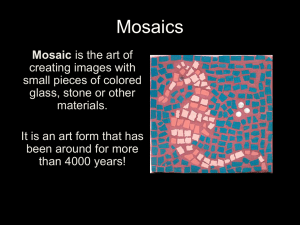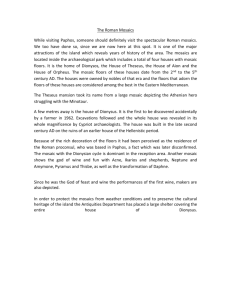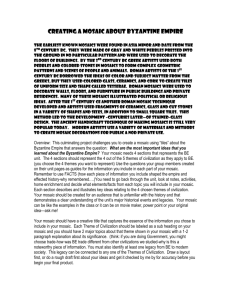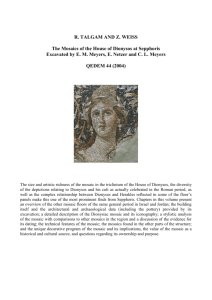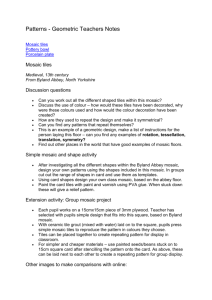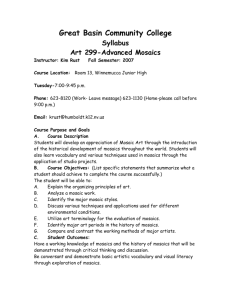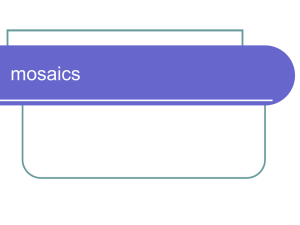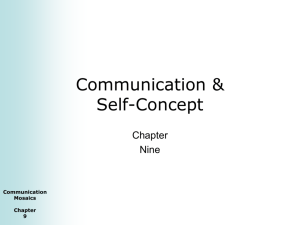Vocabulary Words: Shape, Color, Value, Texture, Space
advertisement
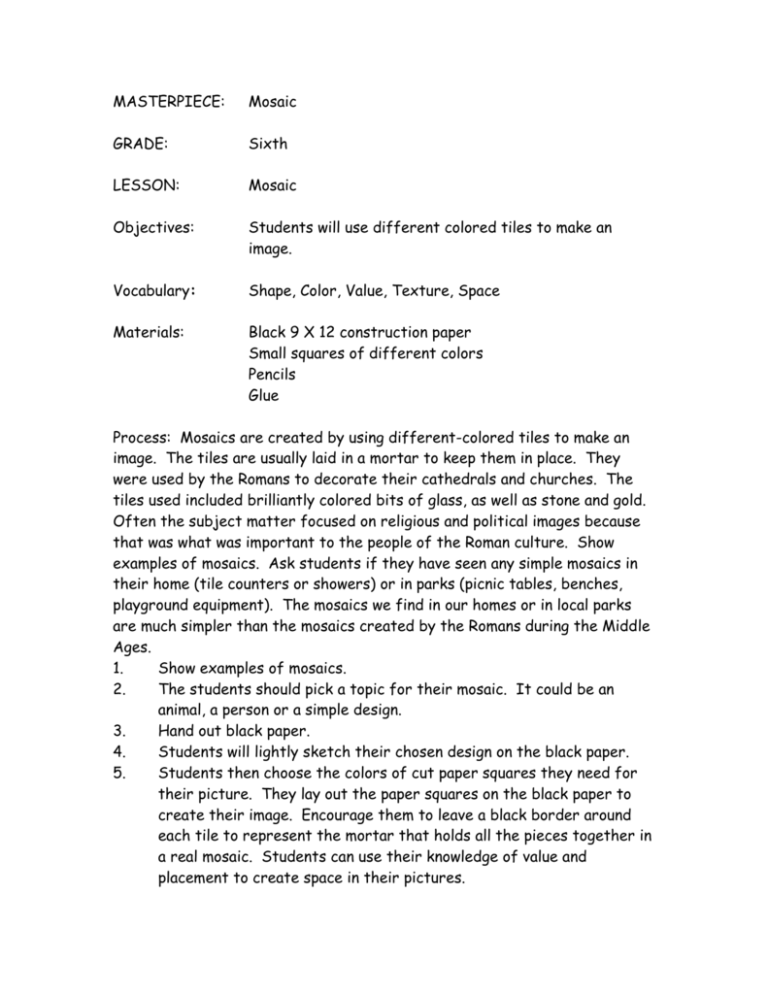
MASTERPIECE: Mosaic GRADE: Sixth LESSON: Mosaic Objectives: Students will use different colored tiles to make an image. Vocabulary: Shape, Color, Value, Texture, Space Materials: Black 9 X 12 construction paper Small squares of different colors Pencils Glue Process: Mosaics are created by using different-colored tiles to make an image. The tiles are usually laid in a mortar to keep them in place. They were used by the Romans to decorate their cathedrals and churches. The tiles used included brilliantly colored bits of glass, as well as stone and gold. Often the subject matter focused on religious and political images because that was what was important to the people of the Roman culture. Show examples of mosaics. Ask students if they have seen any simple mosaics in their home (tile counters or showers) or in parks (picnic tables, benches, playground equipment). The mosaics we find in our homes or in local parks are much simpler than the mosaics created by the Romans during the Middle Ages. 1. Show examples of mosaics. 2. The students should pick a topic for their mosaic. It could be an animal, a person or a simple design. 3. Hand out black paper. 4. Students will lightly sketch their chosen design on the black paper. 5. Students then choose the colors of cut paper squares they need for their picture. They lay out the paper squares on the black paper to create their image. Encourage them to leave a black border around each tile to represent the mortar that holds all the pieces together in a real mosaic. Students can use their knowledge of value and placement to create space in their pictures. 6. Once the images are laid out as desired, the students glue their pieces in place. Vocabulary Definitions: Shape: A flat figure created when actual or implied lines meet to enclose a space. A change in color or shading can define a shape. Shapes can be divided into several types: geometric (square, triangle, circle) and organic (irregular in outline). Color: A color in or related to the spectrum, such as yellow, yellow-orange, blue-violet, green. Hue is another word for color. Color spectrum: A band of colors produced when white light passes through a prism and is broken into separate wavelengths. Visible colors always appear in the same order, by wavelength, from longest to shortest: red, orange, yellow, green, blue, violet. A color wheel shows the approximate visible spectrum arranged in a circle. Value: An element or art that refers to the darkness or lightness of a surface. Value depends on how much light a surface reflects. Tints are light values of pure colors. Shades are dark values of pure colors. Value can also be an important element in works of art in which color is absent or very subtle, such as drawings, prints and photographs. Texture: Texture is perceived by touch and sight. Texture refers to the way a surface feels to the sense of touch (actual texture) or how it may appear to the sense of sight (simulated texture). Textures are described by words such as rough, silky, pebbly. Space: An element of art referring to the empty or open area between, around, above, below or within objects. Shapes and forms are defined by space around and within them. Space is often described as threedimensional or two-dimensional, as positive (occupied by a shape or form) or negative (surrounding a shape or form). MASTERPIECE: Mosaic About the Artist: Mosaics are created by using different-colored tiles to make an image. The tiles are usually laid in a mortar to keep them in place. They were used by the Romans to decorate their cathedrals and churches. The tiles used included brilliantly colored bits of glass, as well as stone and gold. Often the subject matter focused on religious and political images because that was what was important to the people of the Roman culture. CONCEPT: Mosaic GRADE: Sixth LESSON: Mosaic VOCABULARY: Shape, Color, Value, Texture, Space Websites on Mosaic History http://www.thejoyofshards.co.uk/history/index.shtml http://www.frammentiart.com/Mosaic-history.asp http://www.historyworld.net/wrldhis/PlainTextHistories.asp?historyid=ac36 Websites with examples of Mosaics http://images.google.com/images?hl=en&q=mosaic&btnG=Search+Images&gb v=2


